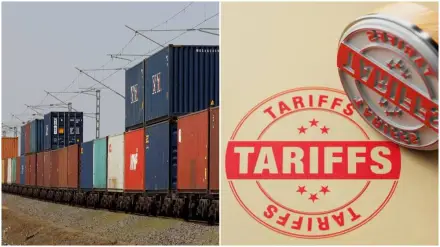Indian exports face a significant blow as the United States enforces steep new tariffs from Wednesday, August 27, 2025. These tariffs, reaching up to 50%, are set to disrupt India’s $87 billion export market to the US, prompted by geopolitical tensions over India’s increased Russian oil purchases. Announced earlier in August 2025, the measure targets a wide range of goods, challenging India’s trade competitiveness. This article explores the context of these tariffs, their implications, challenges, and opportunities for India’s economic strategy.
Context of the Tariffs
Tariff Implementation
-
Effective Date: The US will impose new tariffs, including an additional 25% on top of existing duties, effective from 12:01 a.m. EDT on Wednesday, August 27, 2025, bringing the total to 50% for most Indian goods (web:0, web:1).
-
Scope: The tariffs apply to a broad spectrum of products, with exceptions for pharmaceuticals, semiconductors, and energy resources (web:2).
-
Trigger: The move follows President Donald Trump’s response to India’s purchase of Russian oil, escalating trade pressures amid the Russia-Ukraine conflict (web:3).
Strategic Background
-
Economic Context: India’s $87 billion annual export to the US, representing 2.5% of its GDP, is at risk, with sectors like textiles and gems facing the brunt (web:1).
-
Government Response: Commerce Minister Piyush Goyal has vowed to support affected exporters with financial assistance and market diversification strategies (web:0).
-
Trade History: The tariffs build on a 25% duty implemented on August 7, 2025, with the additional 25% effective after a 21-day negotiation window (web:5).
Global Context
-
Geopolitical Tension: The US justifies the tariffs under Section 301, citing India’s BRICS membership and Russian oil purchases as threats to its economic interests (web:6).
-
Regional Impact: The tariff hike disrupts $434 billion in India’s total exports, with competitors like Vietnam and Bangladesh gaining an edge (web:1).
Implications of the Tariffs
Economic Impact
-
Export Loss: A $4–5 billion drop in engineering exports and a 0.2–0.5% GDP growth decline are projected, revising forecasts from 6.5% to 6% (web:1).
-
Currency Pressure: The Indian rupee weakened 0.17% to 87.7275 per dollar on August 26, raising import inflation risks (web:0).
-
Stock Market: Sectors like gems and textiles saw pressure, though pharmaceuticals rose 2.73% due to exemptions (web:2).
Industry and Trade Impact
-
Sectoral Hit: Textiles, leather, and marine products, comprising 55% of US-bound exports, face a 50% tariff, eroding competitiveness (web:1).
-
Trade Shifts: Increased costs may redirect $2–3 billion in trade to China and Latin America (web:0).
-
Price Setting: US importers may face higher costs, potentially increasing retail prices by 5–10% (web:4).
Social and National Impact
-
Job Risks: MSMEs in textiles and leather, employing 45 million, face reduced competitiveness, risking layoffs (web:1).
-
Policy Focus: The government’s diversification push targets 50 new markets, aiming to offset losses (web:0).
Challenges
Economic Hurdles
-
Revenue Loss: The $4–5 billion export drop could widen India’s $45.7 billion trade deficit with the US (web:1).
-
Inflation Pressure: Higher import costs may push inflation from 4.8% to 5.2% in 2025 (web:4).
-
FII Volatility: Foreign institutional investor outflows could exceed $2 billion, destabilizing markets (web:2).
Operational Constraints
-
Supply Chain Disruption: Companies need 3–6 months to adjust trade routes, risking $1 billion in delayed shipments (web:5).
-
Certification Costs: Diversification requires new certifications, adding 5–7% to export expenses (web:0).
Geopolitical Risks
-
US Retaliation: Further tariffs or sanctions could target $10 billion more in exports if negotiations fail (web:7).
-
WTO Disputes: India’s potential retaliation may strain WTO relations, delaying resolution (web:1).
Opportunities
Economic Advancement
-
Market Diversification: Targeting China and Latin America could add $3–4 billion in exports by 2026 (web:0).
-
Local Boost: Increased domestic consumption could mitigate $1–2 billion in losses (web:2).
Sustainability and Innovation
-
Trade Innovation: E-commerce exports could grow 15%, adding $500 million with digital trade agreements (web:10).
-
Green Shift: Exempted pharmaceuticals could expand into sustainable drug markets, gaining $200 million (web:1).
Global and Regional Leadership
-
Trade Hub Status: Successful diversification could position India as a $500 billion export economy by 2030 (web:5).
-
Diplomatic Leverage: Negotiations could secure tariff relief, restoring $5 billion in US trade (web:9).



